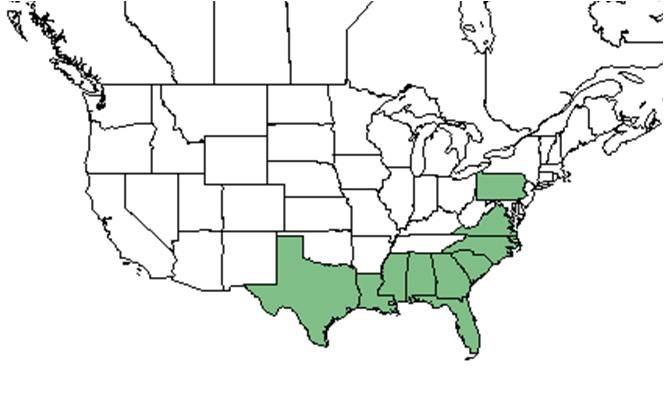Difference between revisions of "Vigna luteola"
KatieMccoy (talk | contribs) |
KatieMccoy (talk | contribs) |
||
| Line 26: | Line 26: | ||
==Ecology== | ==Ecology== | ||
===Habitat=== <!--Natural communities, human disturbed habitats, topography, hydrology, soils, light, fire regime requirements for removal of competition, etc.--> | ===Habitat=== <!--Natural communities, human disturbed habitats, topography, hydrology, soils, light, fire regime requirements for removal of competition, etc.--> | ||
| + | ''Vigna luteola'' can occur along bays, river banks, palmetto hammocks, bordering mangrove swamps, lagoon shores, salt marsh banks, scrub oak-palmetto near the coast, along seepage slopes, and coastal sea oats grasslands. It has also been found in disturbed areas such as cleared borders of slash pine flatwoods and disturbed beaches (FSU Herbarium). Substrate types include loamy sand, sandy loam, and oyster shells (FSU Herbarium). Associated species include ''Bidens laevis, Eupatorium perfoliatum, Aster puniceus, Rynchospora, Uniola paniculata, Helianthus debilis'', and ''Paspalum'' (FSU Herbarium). | ||
| + | |||
===Phenology=== <!--Timing off flowering, fruiting, seed dispersal, and environmental triggers. Cite PanFlora website if appropriate: http://www.gilnelson.com/PanFlora/ --> | ===Phenology=== <!--Timing off flowering, fruiting, seed dispersal, and environmental triggers. Cite PanFlora website if appropriate: http://www.gilnelson.com/PanFlora/ --> | ||
===Seed dispersal=== | ===Seed dispersal=== | ||
Revision as of 15:06, 23 November 2015
| Vigna luteola | |
|---|---|
Error creating thumbnail: Unable to save thumbnail to destination
| |
| Scientific classification | |
| Kingdom: | Plantae |
| Division: | Magnoliophyta - Flowering plants |
| Class: | Magnoliopsida – Dicotyledons |
| Order: | Fabales |
| Family: | Fabaceae ⁄ Leguminosae |
| Genus: | Vigna |
| Species: | V. luteola |
| Binomial name | |
| Vigna luteola (Jacq.) Benth. | |

| |
| Natural range of Vigna luteola from USDA NRCS Plants Database. | |
Common name: hairypod cowpea
Contents
Taxonomic notes
Description
Distribution
Ecology
Habitat
Vigna luteola can occur along bays, river banks, palmetto hammocks, bordering mangrove swamps, lagoon shores, salt marsh banks, scrub oak-palmetto near the coast, along seepage slopes, and coastal sea oats grasslands. It has also been found in disturbed areas such as cleared borders of slash pine flatwoods and disturbed beaches (FSU Herbarium). Substrate types include loamy sand, sandy loam, and oyster shells (FSU Herbarium). Associated species include Bidens laevis, Eupatorium perfoliatum, Aster puniceus, Rynchospora, Uniola paniculata, Helianthus debilis, and Paspalum (FSU Herbarium).
Phenology
Seed dispersal
Seed bank and germination
Fire ecology
Pollination
The following Hymenoptera families and species were observed visiting flowers of Vigna luteola at Archbold Biological Station (Deyrup 2015):
Halictidae: Halictus poeyi
Megachilidae: Anthidium maculifrons, Coelioxys sayi, Dianthidium floridiense, Megachile brevis pseudobrevis, M. exilis parexilis, M. mendica
Use by animals
Diseases and parasites
Conservation and Management
Cultivation and restoration
Photo Gallery
References and notes
Deyrup, M.A. and N.D. 2015. Database of observations of Hymenoptera visitations to flowers of plants on Archbold Biological Station, Florida, USA.